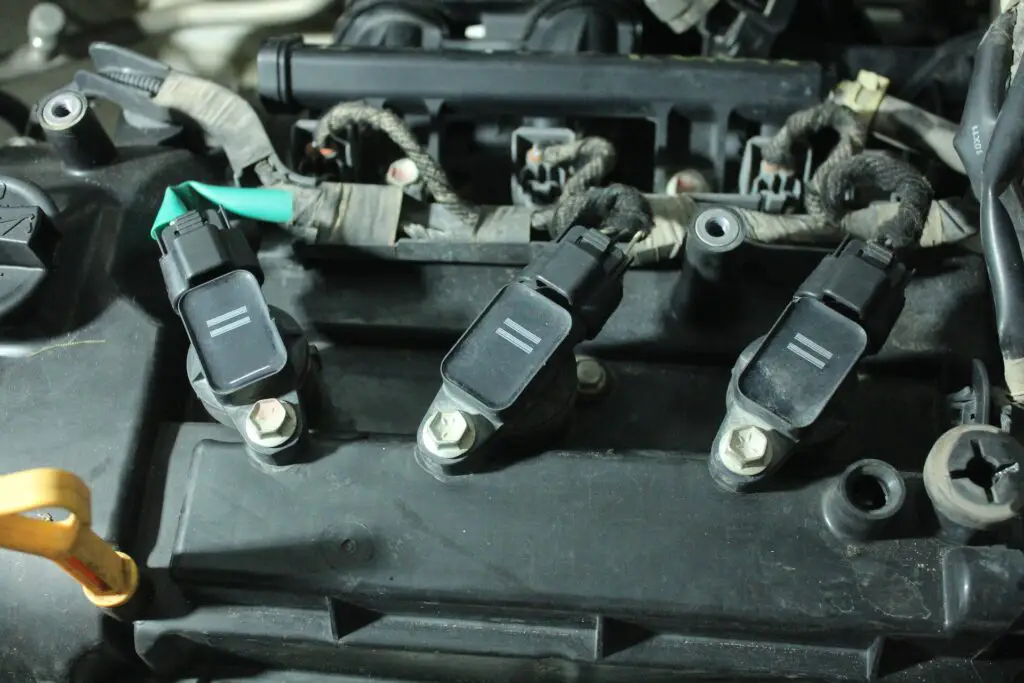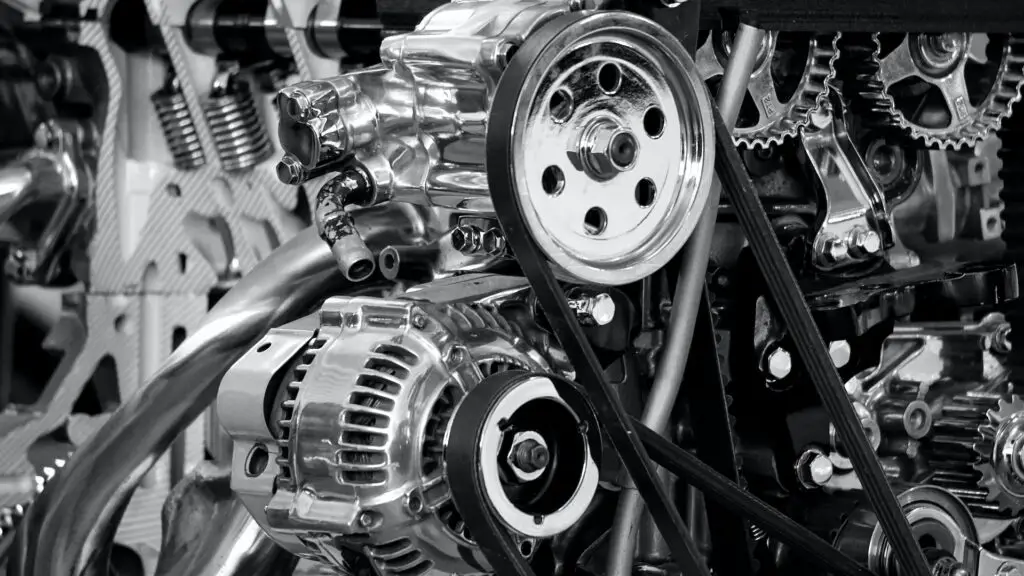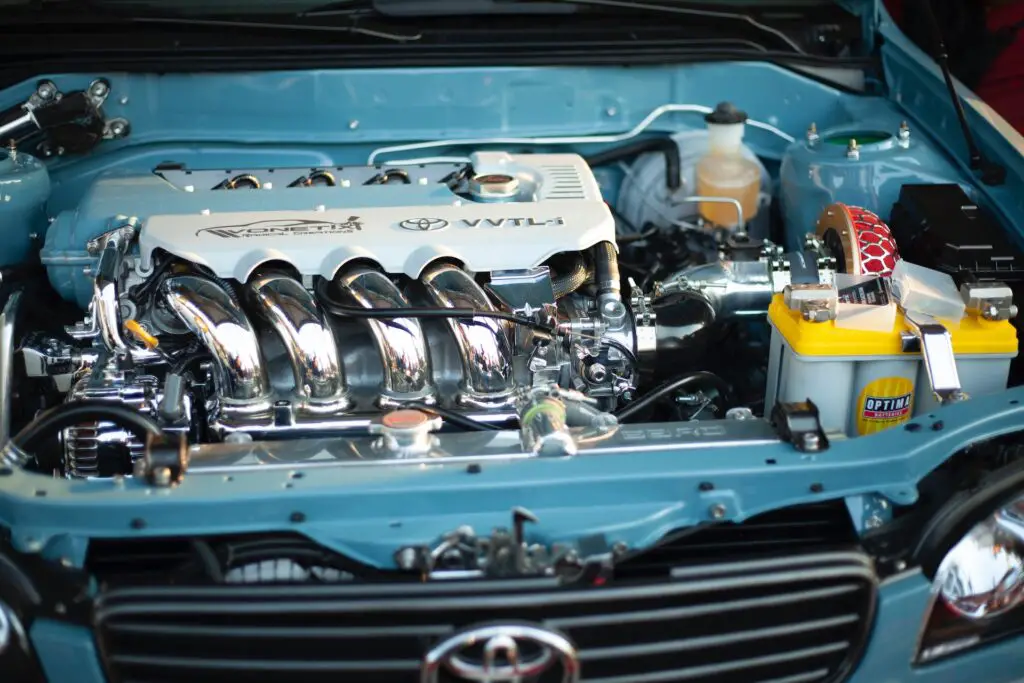A coil pack is a group of ignition coils used in the ignition system of a vehicle. On new and contemporary automobiles, it takes the place of the distributor because coil packs are more dependable than distributors. The computer in the car electrically controls and regulates the coil pack.
You may experience several faulty coil pack symptoms, and you should be aware of them because they may indicate a more significant problem with the engine’s performance.
This is not surprising considering that a coil pack is in charge of storing the energy and turning the battery’s 12-volt output into as much as 45,000 volts before transferring it through the spark plug cables to the spark plug to begin the combustion process.
A minimum of four ignition coils are typically present in an engine, one for each cylinder’s spark plug. The combustion process depends heavily on an ignition coil since without one, the spark plug wouldn’t acquire the necessary voltage.
For spark plugs to ignite the gas and air combination in the combustion chamber, extremely high voltage is required. One should be aware that since the coil pack is crucial to getting the engine started, it could be the cause of any problems you experience starting or driving your car.
Table of Contents
Coil Pack: What Is It?
An electronic component of the ignition system is called a coil pack. The ignition coils in this electronically-controlled pack are managed by the vehicle’s primary computer.
The coil pack’s primary purpose is to build up and increase the necessary energy before releasing the voltage through the spark plug connections. The combustion process begins when the energy enters the spark plugs.
in the brand-new automobile. The distributor takes the position of the coil pack. Because the coil pack is more dependable and consistent than the distributor, this is normal. Additionally, the coil pack offers a better spark, which results in quicker and more efficient combustion as well as more horsepower.
What Is the Purpose of a Coil Pack In a Car?
The spark plugs and coil packs function together. To ensure that the fuel burns in the cylinder, a high-voltage supply is necessary to generate a spark.
The coil pack is in charge of accumulating the required amount of energy as combustion starts. This can go from 50,000 to 75,000 volts in some circumstances.
The signal to release the voltage from the coil pack is then sent by the electronic control module, or computer, to the ignition control. The spark can leap the gap and ignite the fuel-air combination in the cylinder chamber when this voltage reaches the spark plugs.
Where Is the Coil Pack found In a Car?
The majority of gas-powered motors nowadays use coil-on-plug independent coil setups. Each spark plug is supplied with its coil. So, if your engine has eight cylinders and eight spark plugs, it presumably likely has eight coils.
Older engines, however, incorporated coil packs with a distinct coil configuration. There would be a coil pack for several plugs rather than a coil for each spark plug. An eight-cylinder engine, for instance, might have four coil packs, one for each pair of spark plugs.
On the engine, coil packs can be found in almost any place. Each model carries it out differently. These coil packs are frequently separated from the spark plugs by a wire, necessitating their connection. The coil pack is connected to the spark plug wire, which can be found by following it.
The coil pack’s drawback is that if one coil breaks, the whole thing needs to be replaced. The packets cannot be separated because they are molded together.

The Origin of a Coil Pack
Internal combustion engines were dependent for many years on the ignition system’s coil to convert the electrical current coming from the car’s battery.
The distributor then transmitted the spark to a spark plug situated in each cylinder head via the plug wires. The low voltage (usually 12 volts D.C.) from the battery was converted by ignition coils into the high voltage required to ignite the mixture of air and gasoline inside the engine’s cylinders.
The coil was attached to the rotor of the distributor, which spun and produced a pulse arc. The distributor controlled the high voltage using a cap and rotor.
The distributor’s breaker points managed the timing of the spark to the appropriate plug by relying on a vacuum advance or centrifugal advance.
The precise location of each piston is communicated to the engine control unit (ECU) by a sensor in newer vehicles and trucks since spark timing is so important to engine performance.
This enables the control of a transistor, which takes the role of the breaker points and opens or closes current as required, by the vehicle’s computer. A coil pack is a group of ignition coils that use energy from the car’s battery to create a spark that ignites each cylinder separately.
During the late 1990s, coil packs started to take the role of the less effective distributor in vehicles. Additionally, this made it possible to mount ignition coils remotely under the computer control of a vehicle. Coil packs more reliably feed spark to each cylinder for cleaner combustion because there are no moving parts.
The New Development
The spark was routed through a single coil, and electronic signals took the role of the mechanical distributor. A wasted spark ignition system nowadays provides a spark to opposing cylinders on the intake and exhaust strokes at the same time in most 4-cylinder engines.
On the power stroke, one cylinder, which is located in the top dead center, ignites, while the other, which is located on the exhaust stroke, allows burned combustion gases to exit the exhaust.
A coil pack with ignition wires that appear normal is typically used by V6 and V8 engines that fire on opposing banks. In general, coil packs deliver more horsepower for modern high-performance engines.
What are the Symptoms of a Defective Coil Pack?
You may anticipate that the Check Engine Light will turn on and likely start blinking when the coil pack fails. Additionally, the engine could misfire, resulting in higher fuel usage. That leads to a rough idle, difficulty accelerating, a different sound from the engine, and perhaps even a fuel odor.
Any time there is an issue with the engine, many of these symptoms manifest. Because of this, you cannot diagnose a coil pack issue based just on one symptom. Let’s look more closely at these problematic coil pack symptoms to determine what you may be experiencing.
1. Engine Misfiring
Engine misfiring is one of the signs of a faulty coil pack. It can be felt as jerking motions or coughing or spitting sounds when you try to start your car or when it is idling somewhere.
When one or more engine cylinders fire incorrectly or not at all, this happens. This is brought on by a faulty coil that isn’t giving the spark plugs enough voltage.
Engine misfires can occur at any moment, but they typically occur when your car needs to put more effort into it, like when it accelerates. Since engine misfires generate a lot of emissions, they might harm other auto parts like the catalytic converter.
A misfire enables raw fuel to enter the catalytic converter, where it may saturate the inside, stop the afterburner process, and stop oxidation, which leads to a buildup of carbon and eventual clogging.
By altering the fuel-to-air mixture, which can cause your automobile to slow down when you try to accelerate, it can also harm the sensors. Misfires must not be ignored, and the root cause must be removed as quickly as feasible.
2. Engine Ruggedly Idling
A further sign of a poor coil pack is the engine’s choppy idle. When you are driving, it seems like there is some power lacking. When the coil pack malfunctions, rough idling results, thus you must address it as soon as you notice this symptom.

Rough idling can be caused by any mechanical issue that prevents the air-fuel mixture from igniting. Coil packs must be taken into account because of this.
In addition to the coil packs, other potential culprits include dirty fuel injectors, worn spark plugs, and clogged air filters. Because of this, using this symptom alone to diagnose the issue is impossible.
3. Car Backfiring
Backfiring in the car is one of the typical signs of a damaged coil. When combustion occurs in the engine’s intake rather than the chamber, this happens.
An unexpected explosion in the internal combustion engine or, occasionally, in the exhaust results in a loud bang. This can be brought on by a defective ignition coil because it cannot deliver the necessary voltage to the spark plug to finish the combustion process.
Unused fuel remains in the combustion cylinder after incomplete combustion and is expelled through the exhaust pipe. Sometimes the unused fuel in the pipe bursts before it can even burn out. This will cause more significant harm.
When you discover that your automobile is emitting black smoke or that there is a strong odor of gasoline or fire coming from your exhaust, it is recommended to get it checked out as soon as possible. Delaying a repair could result in more extensive damage and more costly issues.
4. Huge Plumes of Exhaust Smoke are Emitted
The exhaust smoke that is produced when the car is operating is another sign of a damaged coil pack. Instead of the usual constant stream of smoke, it just sometimes releases itself.
5. RPMs Decrease During Acceleration
The decrease in RPMs during acceleration may occur if your coil pack is broken. While driving, keep an eye on the RPM gauge to make the determination. The check engine light either illuminates continuously or blinks when the vehicle is being accelerated.
6. Excess Gas Consumption
You will become familiar with how much petrol your automobile uses on each journey once you have been driving it for a long. It may be a sign of a faulty coil pack if you suddenly realize that your automobile is using more gas than usual.
This occurs when the system adds additional gasoline to compensate for the spark plugs’ insufficient power. The additional gasoline consumption makes up for the spark plugs’ lack of power.
A malfunctioning ignition coil might also contribute to poor gas efficiency or bad gas mileage. A faulty O2 sensor reading could result in the system supplying more gasoline than is necessary. Checking it out and fixing it now could save you a lot of money later.
7. The Check Engine Light Illuminates
The Check Engine Light is intended to alert you when there is a problem with the engine. All contemporary automobiles come with an OBD-II self-diagnosis system.
The Check Engine Light illuminates and a code is stored in the system when an engine sensor detects something functioning outside of normal parameters. The light will blink if there is a serious issue, alerting you to halt driving before engine damage occurs.
You can find out what’s wrong by reading the trouble codes coming from the engine sensors with a suitable scanner. A P0351 error code may be shown by your car, which denotes an ignition system issue. A code of the engine misfire can also be seen.
8. A Car Fails to Start
One of the poor coil pack symptoms could be the cause of your automobile not starting. A coil pack of broken ignition coils fails to spark, which prevents your engine from starting.
Even if the starter motor is turned, the voltage required to light the spark plugs is not reached. The engine won’t start if the ignition is missing throughout the combustion process. This issue is frequent during the colder months and periods of excessive humidity.
9. Troubles During Acceleration
The same holds for acceleration issues. While it is a sign of a bad coil pack, most engine problems can also be caused by it.
When you press the accelerator, if there is a loss of power, there is a problem that needs to be fixed right away. If you don’t fix the issue, the car can start to stall.
10. A Weird Engine Sound
We previously discussed an engine that was misfiring. Additionally, you can hear some unusual noises along with this symptom. You will notice a louder sound as the engine jerks and bucks.

Your engine sound may alter if the coil pack is damaged since it may force the engine to run on one or more cylinders less than usual.
The vehicle might also retort in dire circumstances. When unburned fuel escapes from the exhaust, a loud banging sound is made. You should get this addressed so that you can avoid embarrassing sounds as well as further damage.
11. Excess Gas Odor
You might detect a faint aroma of gasoline if the fuel mixture isn’t burning properly. However, this symptom might also be caused by other things besides ignition issues.
The fuel or exhaust system is usually to blame when there is a gasoline smell. This symptom may be brought on by the coil packs or spark plugs if it also coexists with some of the other symptoms we discussed.
12. Car Stalls
A faulty coil pack may be to blame if your automobile stops while you are driving or even while you are already stopped. A malfunctioning coil initially sends erratic electrical currents to the spark plug.
Because of this, you can start and drive your car without having a stall. Your automobile can finally stop completely if the stalling occurs while you’re driving, and it will be more difficult for you to restart the vehicle.
13. Coil Pack with Cracks
Observing a coil pack is one approach to spotting a weak one. An ignition coil pack often has a box-like design, with one coil for each cylinder. Every time you drive your automobile, the pack and coils are exposed to heat.
You can keep an eye on it continually to watch for any obvious cracks or damage, as well as any loose coil connectors.
When you notice cracks, it is advisable to have the coil pack replaced rather than waiting for another problematic coil pack symptom. Early action is always preferable to suffering later.
How Can You Diagnose a Defective Coil Pack?
Despite its dependability, ignition coils can malfunction for several causes, including vibration and intense heat. However, the most typical cause of their failure is voltage overload brought on by faulty spark plugs or plug wires.
To determine whether they have any issues, you should conduct a diagnosis if you notice any of the problematic coil pack symptoms. The following techniques for testing a coil pack are covered:
1. Perform a Visual Inspection
Checking your coil pack and each ignition coil to see if there are any apparent cracks, corrosion, burn marks, or carbon tracking is one thing you may do.
Verify the housing of the ignition coil to see if it is in excellent shape and look for any oil leaks. Check the ignition system’s wiring as well for any potential burns or damage.
2. Test Using an Ohmmeter
Using an ohmmeter, you must test the coil’s primary and secondary resistance to determine whether it is fully functional.
To measure the secondary resistance, attach the ohmmeter to the positive (+) terminal and the high-voltage output terminal. If the coil is brand-new, a reading of between 6,000 and 8,000 ohms is typical; nevertheless, some coils can read as high as 15,000 ohms.
By attaching the ohmmeter to both the positive (+) terminal and the high-voltage output terminal, you may measure the secondary resistance. If the coil is brand-new, a reading of between 6,000 and 8,000 ohms is typical; nevertheless, some coils may read as high as 15,000 ohms.
Although testing is done while the car is at rest rather than when the coil is hot or under load, ohmmeters are becoming less common because the data they provide are not entirely certain. The weak and defective coil may thus pass the resistance test as a result.
3. Test Using a Scanner
The ignition coils can also be tested using a scanner. You can replace or change the suspected damaged coil to another cylinder and check it for potential misfires because a coil pack has many coils for each cylinder.
To cancel out each cylinder without a scanner, perform a power balance test. You must pay attention to the RPM drop as you remove each cylinder to accomplish this.
The defective cylinder, which makes little effect when shut off, is not a major contributor to the engine’s RPM.
You will need to move the coil to a different cylinder and repeat the power balance test to rule out these possibilities because other technical issues and fuel delivery might also result in a decrease in RPM. Remove the defective coil if the output remains the same.
4. Test Using a COP (Coil-On-Plug) Probe
Additionally, there is a device known as a coil-on-plug (COP) probe. To determine whether the coil is firing, this gadget employs magnetic induction.
One probe has a screen that shows data, and another has a light that flashes to indicate that the coil is operating properly. You can operate it correctly according to the guidelines in its manual.
5. Test Using a Spark Tester
Utilizing a spark tester is an additional option. To check whether the coil is sparking or not, this tool must be positioned in line with the ignition coil pack.
Since not all testers are compatible with all kinds of ignition systems, it would be preferable if you bought or used a reliable, adjustable spark tester. Always use the appropriate one.
You may be aware that an alternative to using a spark tester is to remove the spark plug and ground it. While this can also ignite the spark, firing a spark plug that has been removed from the engine requires less voltage than firing one that is still in place.
Jumping the plug gap while the engine is running might not be sufficient. Spark testers are safer than grounding the plug since they not only provide accurate measurements or results when testing the coil pack to see if it is producing enough spark to jump the plug gap.
6. Test Using an Oscilloscope
The signs of a bad coil pack can be quite similar to those of other auto parts. Because of this, you must be careful to avoid getting the wrong diagnosis. An oscilloscope is one of the greatest devices for diagnosing coil pack issues.
The wave pattern of the ignition system is shown by this gadget. Waveforms are used to measure the electrical signal as it changes over time. The fact that this instrument is fairly pricey is its only drawback. However, buying auto diagnostic instruments is usually a smart move.
No matter what technique you use, never attempt to disconnect a plug wire or a high-voltage output wire to check for a spark. A dangerous open wire can deliver a powerful shock.
Additionally, abruptly unplugging the wire increases the voltage demand, which can harm the coil. So, when you see the signs of a faulty coil pack, test the coil’s resistance using the right procedure.
Is It Safe to Keep Driving When You Have a Bad Coil Pack In Your Car?
Although you might still be able to drive the car, we don’t advise it. Due to its unpredictable nature, there may be performance problems as well as a chance of destroying other crucial components. For instance, if you drive your automobile in this manner, the catalytic converter will soon stop working.
What Is the Cost of a Coil Pack Replacement?
For a coil pack replacement, budget between $300 and $500 on average. This price includes both the labor and the parts for a typical automobile. Depending on your location, the car you drive, and the number of coil packs that need to be changed, prices may vary.
You might also want to change the spark plugs at the same time. You might as well replace them while you are working on the vehicle if it is almost time to do so as part of your routine maintenance.
Additionally, you will also save money if you can complete any of this work on your own. With a few simple tools and some automobiles, replacing the coil packs is straightforward.
It’s interesting to note that in recent models, replacing a coil pack often costs more than doing so for a single coil over a plug. This device inherently costs more because it manages several spark plugs.
They may also be more difficult to locate because they are on older cars. If your neighborhood auto parts store doesn’t have coil packs in stock, you might need to order them online.
How Often Does a Coil Pack Go Bad?
The coil packs don’t often have a suggested service interval specified by the manufacturers. Only repair them as necessary because modern automobiles don’t use this outdated technology. The majority of coil packs should operate trouble-free for at least 100,000 miles.
The Conclusion
The symptoms of a faulty coil pack are typical of the types outlined above. Understanding these indications might help you decide what steps to take to address the issue with your car.
Your car should be checked out and fixed as soon as you notice one or more symptoms. Delaying it could result in more severe issues, such as decreased engine performance and a damaged catalytic converter.
Your safety is also put at risk if you operate a vehicle that frequently stalls, misfires, and stops while you are driving. Just keep in mind that even if one coil fails, the others are likely to follow quickly.
Fortunately, the majority of ignition coils are inexpensive and simple to repair. A professional inspection of your vehicle is the only surefire approach to address and eliminate the signs of a damaged coil pack.
Your car won’t give you any trouble any time soon if you take good care of it and keep up with routine maintenance and services.
RECOMMENDED TOOLS
Here are our recommended tools on Amazon that have been tried and tested by our experts.
- Auto Jump Cables
- Read – Reset OBD Diagnostics
- Professional OBD Diagnostics
- Professional Car Jacks
- Socket Wrench Ratchets
- Mechanics Tool Set
- Rechargeable LED Work Lights
- Impact Wrench Kit
- Digital Multimeter
- Battery Charger
Motor Pinnacle is a participant in the Amazon Associates Program. We will earn a small commission when you purchase any product using our affiliate links. This is at NO added cost to you. By utilizing our affiliate links, you are assisting us to keep this blog running; we are so grateful for that.

Hi, I’m Maurice Nyangano. A certified auto expert who has been in the business for over fifteen years and has worked as a service writer for five years. I take great satisfaction in providing factual information in my buyer’s guides, comparisons, expert repair guides, and car reviews. I write automotive blogs to assist fellow auto experts and car owners in troubleshooting various car issues and offering fixes.






